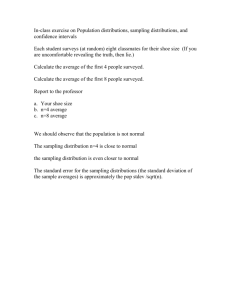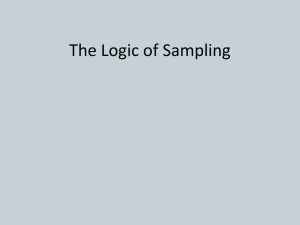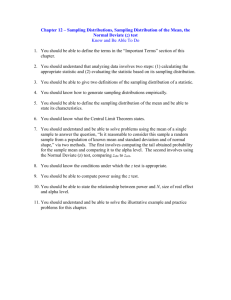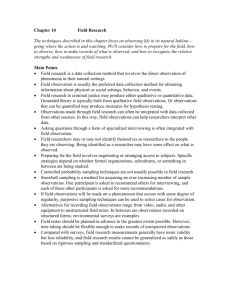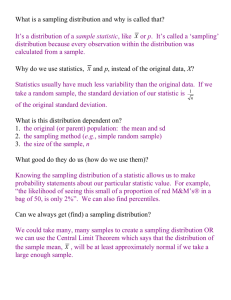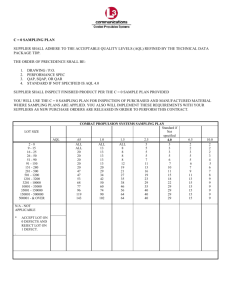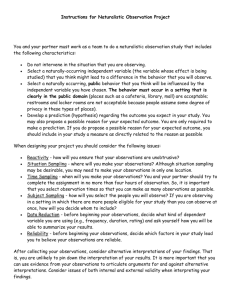Sampling Techniques: Random, Systematic, Stratified & More
advertisement
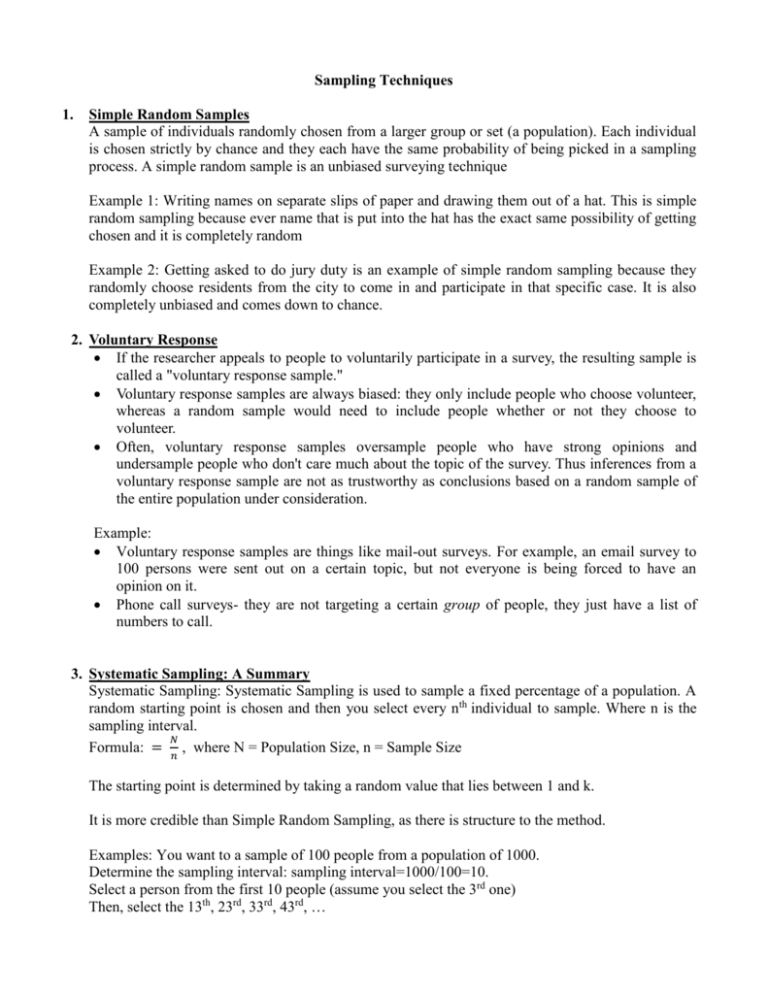
Sampling Techniques 1. Simple Random Samples A sample of individuals randomly chosen from a larger group or set (a population). Each individual is chosen strictly by chance and they each have the same probability of being picked in a sampling process. A simple random sample is an unbiased surveying technique Example 1: Writing names on separate slips of paper and drawing them out of a hat. This is simple random sampling because ever name that is put into the hat has the exact same possibility of getting chosen and it is completely random Example 2: Getting asked to do jury duty is an example of simple random sampling because they randomly choose residents from the city to come in and participate in that specific case. It is also completely unbiased and comes down to chance. 2. Voluntary Response If the researcher appeals to people to voluntarily participate in a survey, the resulting sample is called a "voluntary response sample." Voluntary response samples are always biased: they only include people who choose volunteer, whereas a random sample would need to include people whether or not they choose to volunteer. Often, voluntary response samples oversample people who have strong opinions and undersample people who don't care much about the topic of the survey. Thus inferences from a voluntary response sample are not as trustworthy as conclusions based on a random sample of the entire population under consideration. Example: Voluntary response samples are things like mail-out surveys. For example, an email survey to 100 persons were sent out on a certain topic, but not everyone is being forced to have an opinion on it. Phone call surveys- they are not targeting a certain group of people, they just have a list of numbers to call. 3. Systematic Sampling: A Summary Systematic Sampling: Systematic Sampling is used to sample a fixed percentage of a population. A random starting point is chosen and then you select every nth individual to sample. Where n is the sampling interval. 𝑁 Formula: = 𝑛 , where N = Population Size, n = Sample Size The starting point is determined by taking a random value that lies between 1 and k. It is more credible than Simple Random Sampling, as there is structure to the method. Examples: You want to a sample of 100 people from a population of 1000. Determine the sampling interval: sampling interval=1000/100=10. Select a person from the first 10 people (assume you select the 3rd one) Then, select the 13th, 23rd, 33rd, 43rd, … 4. Stratified Sampling Technique Strata: A population divided into a group (i.e age, geographic location and place of work etc.) Stratify Random sampling: Population is divided into two group (strata) and a random sample is taken within each group. The strata sample is proportion to the stratum size. A larger stratum size means a larger strata. Most Common Uses: • To make a statement about a sub-population • To increase the accuracy of estimates over the entire population • A school could be divided based on grades • A province could be separated into countries of origin Example: At PHS there are 20 students in grade 9, 30 students in grade 10, 26 students in grade 11, and 24 students in grade 12, for a total of 100 students. The data would be split up by grades. From there the researcher would select a set number of students from each class to represent the final population. If you wanted to take a sample of 50 kids, 20% would be from grade 9, 30% from grade 10, 26% from grade 11 and 24% from grade 12. That would be 10 from grade 9, 15 from grade 10, 13 from grade 11, 12 from in grade 12. 5. Cluster Sampling Cluster samples require populations to be structured in groups. Cluster sampling is typically used when the researcher cannot get a complete list of the members of a population they wish to study but can get a complete list of groups or 'clusters' of the population. A random sample of groups would then be chosen. All members of the chosen groups would then be surveyed. For example: schools, communities, companies and leagues. 6. Destructive Sampling Destructive sampling entails samples from which the selected element cannot be reintroduced into the population. Sampling where results are taken but the element is no longer usable after. For example: light bulbs and firecrackers tested for quality control. • Destructive sampling entails samples from which the selected element cannot be reintroduced into the population. • Sampling where results are taken but the element is no longer usable after. • For example: light bulbs and firecrackers tested for quality control. Suppose that the Department of Agriculture wishes to investigate the use of pesticides by farmers in England: • A cluster sample could be taken by identifying the different counties in England as clusters. • A sample of these counties (clusters) would then be chosen at random, so all farmers in those counties selected would be included in the sample. • It can be seen here that it is easier to visit several farmers in the same county, than it is to travel to each farm in a random sample to observe the use of pesticides. What is destructive sampling? • Destructive sampling entails samples from which the selected element cannot be reintroduced into the population. • Sampling where results are taken but the element is no longer usable after. • For example: light bulbs and firecrackers tested for quality control. A test is conducted, where a Destructive method works that explodes every one thousandth firecrackers to test that the other 999 firecrackers will work when ignited: • The 1000th fire cracker is ignited to insure the 999 before will ignite when consumer ignites the product • This is destructive sampling because the 1000th firecracker will not be able to be reintroduced to the population, but must be done to insure quality of product. 7. Multi-Stage Sample Multistage Sampling is a sampling strategy used to conduct studies within large populations. The overall population is divided into smaller clusters and sub-clusters, which the research will randomly select samples. Example: Conducting a survey of salespeople for a nationwide retail chain throughout Canada. The survey is distributed to randomly selected provinces, randomly selected counties in each province, randomly select stores in each county, and randomly select salespeople in those stores. This is Multi-Stage sampling, because how the surveys are distributed is selected at random. Example: Survey teachers in Enugu, Nigeria, in order to examine teacher’s attitudes/opinions towards adolescent sexuality education. First-stage sampling included 20 secondary schools in the region that were randomly selected. The second stage of sampling selected 13 teachers from each of these schools. This is a form of Multi-Stage sampling, because the schools and teachers were selected at random, through the region. This gives a more divided opinion as everyone participating in the survey was across the region. 8. Convenience Sample Convenience sampling chooses individuals that are easiest to conduct studies on and/or sampling that is easiest to do. This form off sampling is considered bias, because it does not represent the entire population. The selection of units from the population is based on easy availability and/or accessibility. Example: If you want to choose 5 people from a class of 50. You could choose: First 5 students who raise their hand. First 5 students in the first row. 5 tallest students. This is considered convenience sampling because, all the students chosen have a common aspect. Example: Having a survey given to one class at Preston High School to see what the most preferred type of pizza the students like. This is considered convenience sampling, because the one class that is being surveyed is supposed to represent the entire population of the school. This creates a bias opinion of what the students like. 9. Longitudinal Studies Longitudinal studies sample small groups of people to examine the effects on each individual over time. This form of study is taken over a long period of time towards a small sample group. Longitudinal studies are most commonly used in sociology to observe the changes in lifetimes or generations. Benefits: long term progress can be monitored. Risks: bias without follow-up, bias with participant drop-out Example: identifying which families suffer from abuse, children were asked when they were 18 months, again when they were 4, when they were adolescence and when they were approximately 18. They discovered that depression is more commonly found in children with a history or family violence. 10. Cross Sectional Studies Cross sectional studies can compare different population groups at single points in time (snap-shot) Considers only present data. Aim is to define a certain population. Benefits: can easily compare different variables, cost effective, no loss to follow up Risks: May not give enough information about the cause and effect relationship, data may vary Example: an example of cross-sectional study is researching how common breast cancer is in a large population. A researcher can look at different ages, ethnicities and social backgrounds along with other categories. This means that if they find that women from a social background have the cancer, the researcher can investigate further. Which to Choose: When conducting a study, one must consider the time span and sampling group. How do the opinions of students change based on the number of years they have been in high school? If you are in grade nine, it is easy to ask your grade every single year until grade 12. However, if you are in grade 12, it is easier to ask a few students from every single grade. It would be a cross sectional study if you were in grade 12. You’d be asking a students’ their opinions now on school, which means the study would be complete faster. It would be a longitudinal study if you were in grade nine. It would be conducted over four years and a small sample of students would be asked. You would get the answers from the same students to monitor their progress and changing opinions. 11. Questionnaire Question types Information question: An information question is a question which is introduced through the words who, which, what, where, when or how. Information questions are answered with “yes” or no. Example: An example would be asking “Where did I put my keys?” Check-list question: A check-list question is a list of questionnaire where participants have to check off all applicable information related to the question. Example: An example would be asking “Which of these characteristics best describe you, check as many as apply,” and having checkboxes beside the choices. Ranking question: A ranking question is a question which asks the participant to compare two or more objects and properties and order them on a numeric scale. Example: An example of a ranking question would be providing the participants with a list and asking them to rank the items on the list in order of importance. (Providing a list of sports and asking participants to rank them from best to worst). Rating question: A rating question is a question that asks the participant to position each property or object on a verbal, numeric or graphing continuum. Example: An example of a rating question would be asking participants their opinions one on particular item. (Asking them their opinion, out of ten, about a movie). 12. Questionnaire Question Types: Open, Closed, Leading and Loaded Open Questions are answered in the respondent’s own words. e.g. What is the most important issue for teenagers in your community? What do you feel contributed to your success today? Closed Questions require the respondent to select an exact answer. e.g. Does four plus four equal eight? What is your favourite meal of the day? o Breakfast o Lunch o Dinner Leading Questions encourages the desired answer by using emotionally prodding words. e.g. You're going to donate to that well known and deserving charity, right? Don't you agree that this week's interesting lecture is better than last week’s boring lecture? Loaded Questions contain an unjustified assumption. It is worded in such a way so that the respondent who answers the question directly admits to accepting that assumption. e.g. How easy was it to find what you were looking for today? Are you falling asleep 13. Margin of Error • • • • • • • • • The margin of error is a statistic that can be calculated that expresses the amount of random sampling error in a survey’s results. The margin of error changes depending on how confident you want your results to be (e.g. 90%, 95%, or 99%) There are many different formula’s used to calculate margin of error, the most basic being MoE = +/- 1.29/square root n(99%confidence), n being the sample size. The 1.29 value changes depending on the desired confidence (e.g. 0.98 for 95% confidence) Elections Question: A student surveys a random sample size of 400 people on they want to win the election, if one happened right now. The student wants 95% confidence to ensure that she gets results that would be true for an election. What is the margin of error? Answer: MoE = +/- 0.98/square root n = +/- 0.98/ square root 400. =+/- 0.98/20 =+/- 0.049, which is equal to =+/- 4.9%. Therefore the margin of error for this sample would be plus or minus 4.9%, if the student wants a 95% confidence value. Sports Survey • Question: If 1600 people are surveyed about what their favourite sport is and the surveyor wants a 99% confidence value for his survey, what is the margin of error that he is allowed. • Answer: MoE = +/- 1.29/ square root n • = +/- 1.29/ square root 1600 • = +/- 1.29/40 • = +/- 0.03225, which is equal to a plus or minus 3.23% margin of error. Therefore if he/she wants a 99% confidence value for this survey, they must have a margin of error of less 3.23%, but more than -3.23%.

